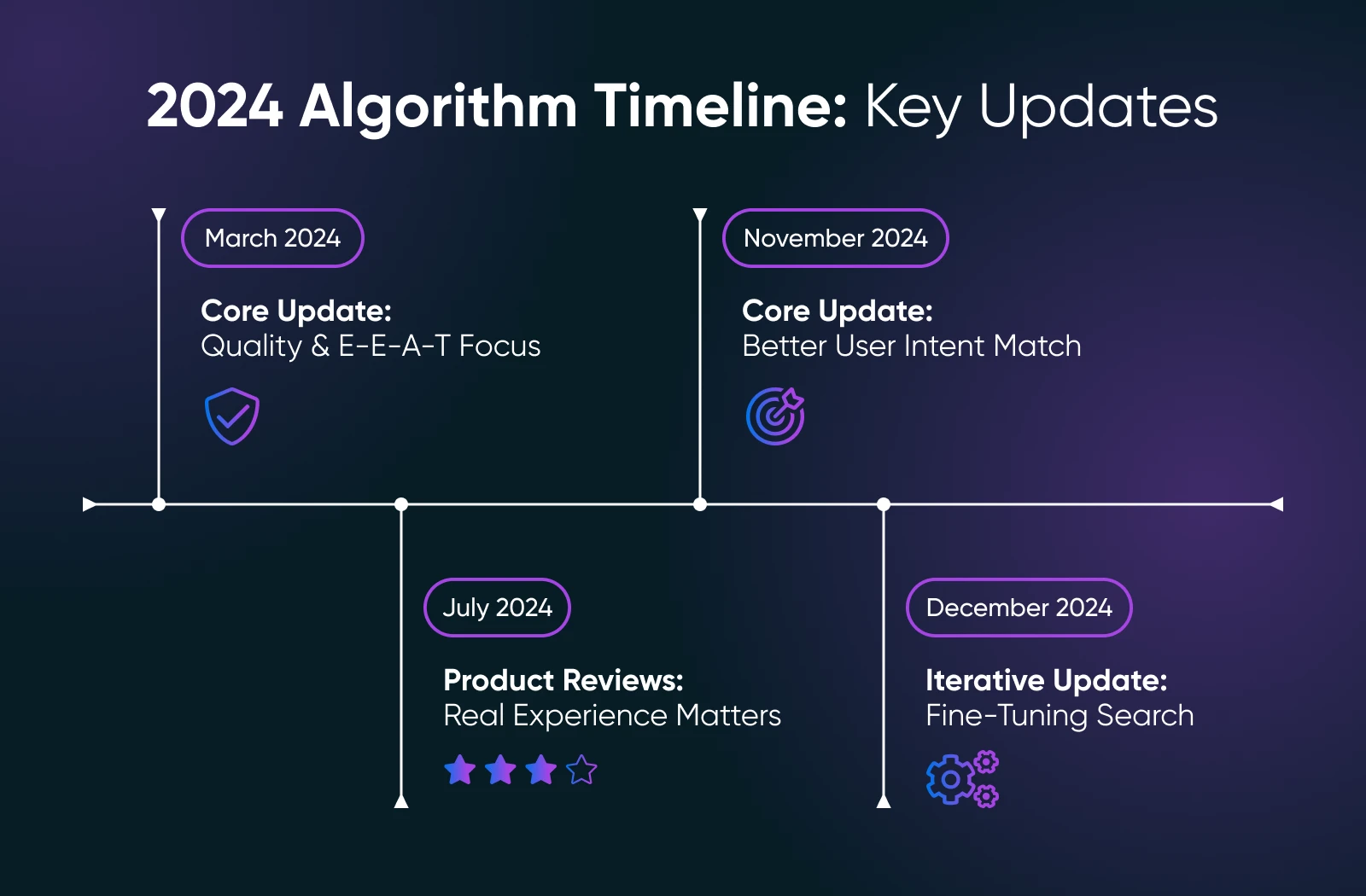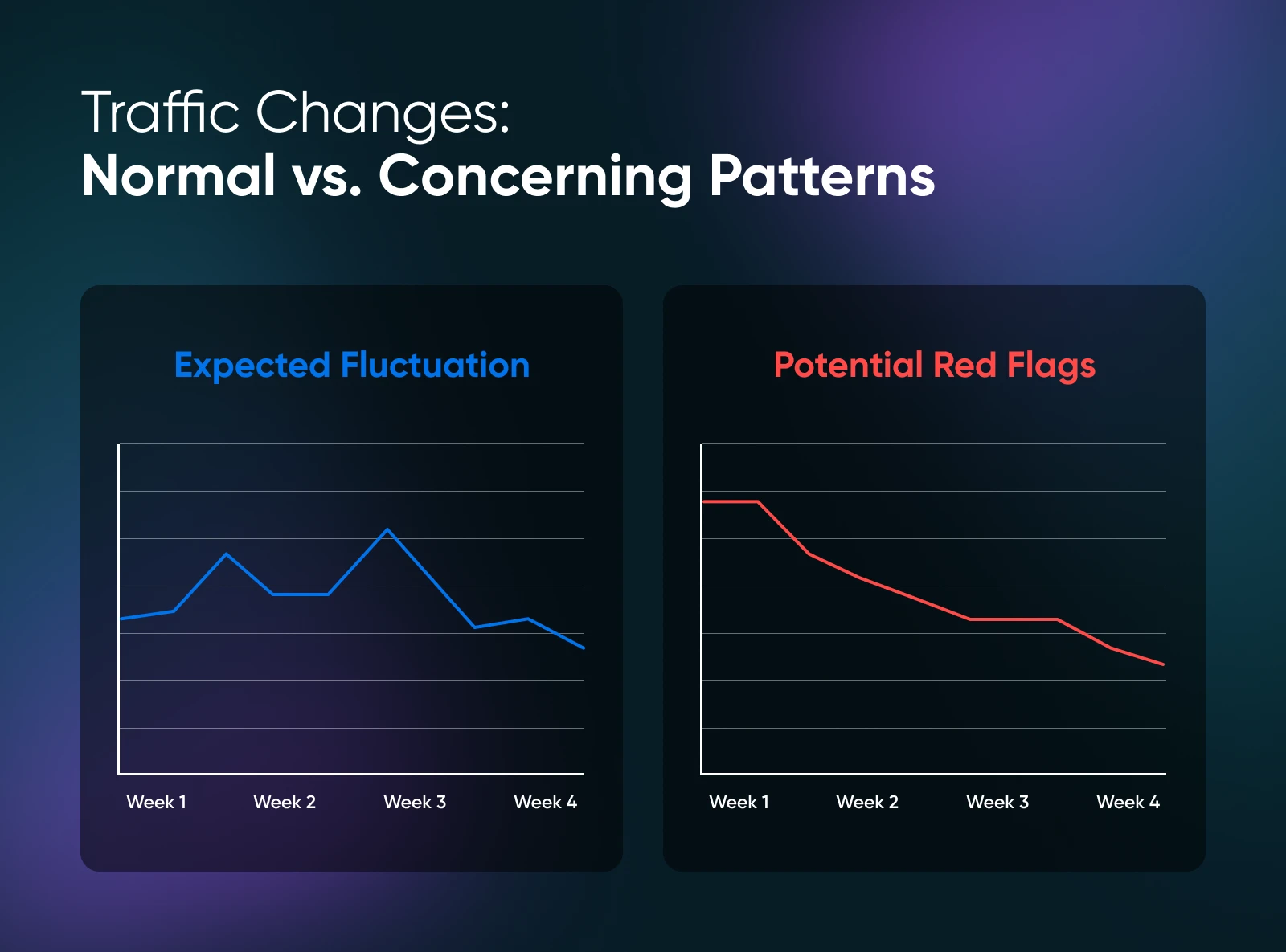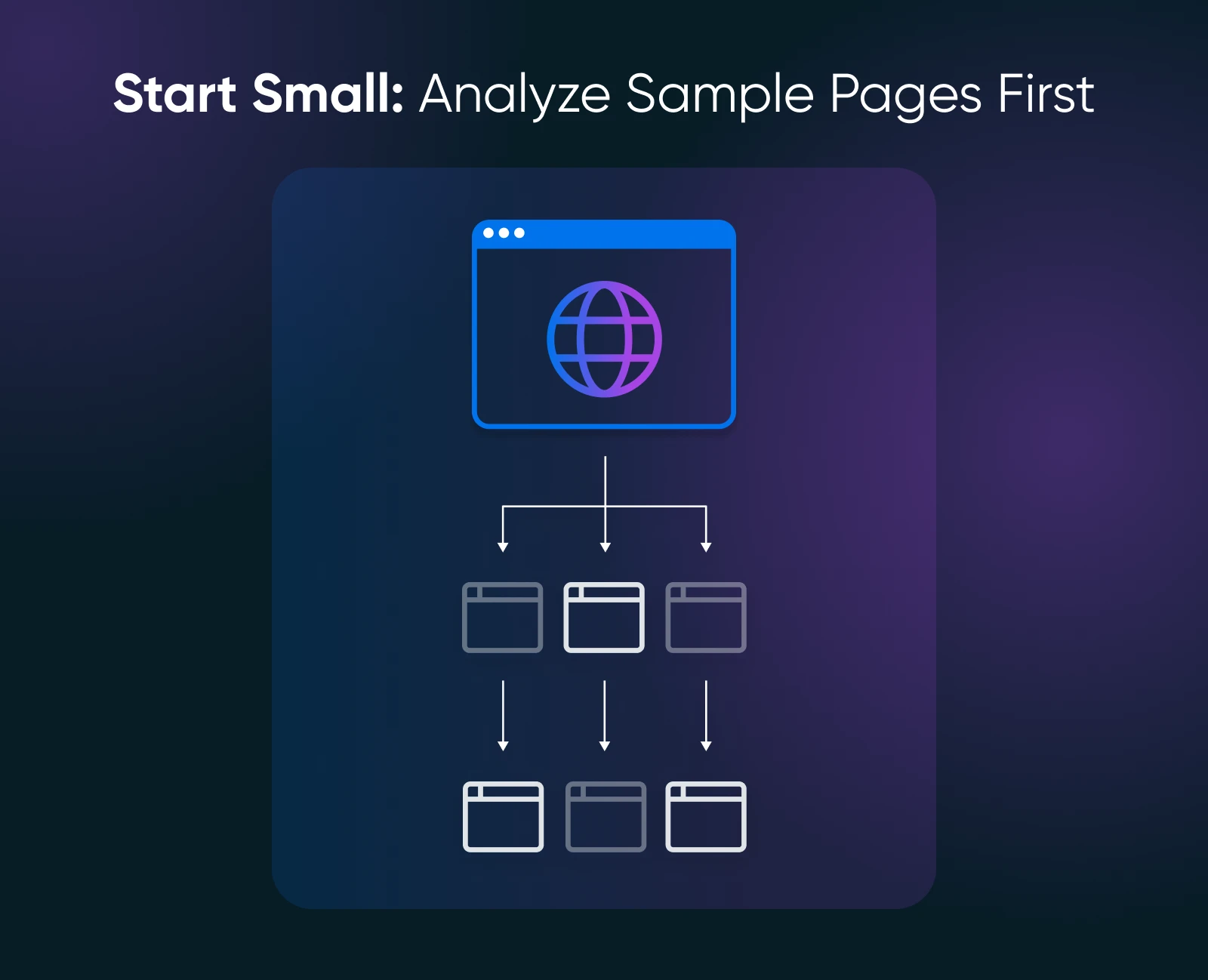How To Navigate Google Algorithm Updates

Uh oh. You’re scrolling through your social feed when you see it: Google just released a new core update. You instantly wonder, “Does this mean my traffic is going to drop? Am I about to lose business?” You’ve heard horror stories about sites getting wiped off the search map by algorithm changes —so it’s hard not to feel at least a little bit nervous.
The good news? An algorithm update isn’t a guaranteed headache —and it certainly doesn’t have to spell doom for your business. In fact, it can be a good opportunity to refine your content, improve your user experience, and make sure the people who need what you offer can find you.
So what do you do now?
Before you start rewriting every piece of content on your site or pay for sketchy quick-win SEO “fixes,” take a deep breath. You’re not alone, and you certainly aren’t helpless. Below, we’ll explain exactly what these updates are and what they mean for small businesses like yours. We’ll show you what you should do — and what you definitely shouldn’t —to navigate a Google algorithm update with confidence.
What Is a Google Algorithm Update?
A Google algorithm update is a change to the complex formula Google uses to determine which websites rank where in search results.
The idea behind these updates is pretty simple: Google wants to provide the best possible answers to users’ queries, surfacing the most helpful, trustworthy information at the top.
That might mean putting more emphasis on authoritative content (so that health advice comes from doctors, not random strangers) or making sure that mobile-friendly sites rank higher on smartphone searches. Some updates are small and almost imperceptible, while others, known as core updates, can shake up entire industries.
Many people treat the Google algorithm as a mysterious enigma, shrouded in secrecy. But via its Google Search Central resource, Google actually provides quite a lot of information about how the algorithm works and what you need to do to get your site to rank. It notes that it’s regularly making changes, some big, some small, to “surface more relevant and useful results.”
In fact, Google has publicly stated that its primary mission is to help users find the highest quality content. As the search giant explains in its guidance on core updates, they’re “designed to ensure that, overall, we are delivering on our mission to present relevant and authoritative content to users.”
This isn’t about punishing good sites or randomly shuffling the deck; it’s about continuous improvement. Google’s own documentation highlights the importance of aligning your content with user expectations and maintaining E-E-A-T (Experience, Expertise, Authoritativeness, Trustworthiness). Sites that consistently deliver value, clarity, and trust stand a better chance of weathering algorithmic shifts.

In other words, Google’s core philosophy isn’t a secret: Create useful content, present it well, keep your audience front-and-center, and you’ll do just fine in the long run.
How Often Does Google Update Its Algorithm?
Google is tinkering with its algorithm all the time. Hundreds (even thousands) of small changes might roll out each year. However, the big, headline-grabbing core updates happen less frequently. Typically a few times a year, at most.
Think of it like the difference between rearranging a few books on your shelf each day versus deciding to renovate your entire living room. Most days, Google is just shuffling a few titles around (minor tweaks), but every now and then, it knocks down a whole wall — i.e., a core update. It’s important to know (and be able to spot) the differences, so you can approach algorithmic changes calmly and without jumping to conclusions every time you see a slight change in your traffic.
Big Updates With Big Implications
Over the past several years, Google has rolled out core updates that have dramatically affected search results. Some focused on content quality, others on-page experience, and some on overall trust and authority.
Recently, there have been a few major updates announced close together that have had the SEO world buzzing:
- December 2024 Iterative Update: Just a few weeks after its prior core update, Google introduced another wave of refinements. While not as dramatic as November’s shift, changes in search results occurred just days after the announcement, according to Search Engine Journal. The impact of this update is still being tracked and monitored.
- November 2024 Core Update: Rolled out to improve the way Google understands and ranks content that matches user intent. According to Search Engine Journal’s coverage, this update continued “Google’s refinement of search systems to enhance the quality of results” and caused modest changes for most sites after its rollout was completed on 5th December 2024.
- July 2024 Product Reviews Update: Mid-year, Google refined how it evaluates product review content. Historically, product review updates have placed greater weight on first-hand experience, transparent pros and cons, and demonstrably authentic insights. The July 2024 iteration continued this trend, making it harder for shallow, affiliate-driven reviews to rank well. Detailed product comparisons, hands-on testing, and authentic imagery helped standout reviewers rise.
- March 2024 Core Update: The first core update of 2024 landed in March and set the tone for the rest of the year. This update honed in on what Google often emphasizes: quality and relevance. Sites that had invested in thorough, well-structured content — especially those demonstrating strong E-E-A-T principles — maintained or even improved their rankings. Meanwhile, web pages with outdated or thin content often slipped.
If we look further back, earlier core and iterative updates show a pattern: Google repeatedly pushes toward highlighting genuinely helpful content and filtering out low-value pages.
Each time, the takeaway remains consistent: Your best bet is to keep improving quality, trust, and relevance.
When another big update lands, it’s helpful to look at how your site fared in previous rollouts and draw lessons. Patterns often emerge, and if you’ve been proactive, the changes might feel more like gentle course corrections than shockwaves.

How Google Algorithm Updates Impact Small Businesses
For entrepreneurs and small-to-medium-sized businesses (SMBs), organic search traffic can be a make-or-break success metric. It’s a constant stream of potential customers finding you naturally, with no need for expensive ads or promotions. That’s why it’s so important to understand algorithm updates. If you’re not prepared, a sudden drop in rankings can feel like someone suddenly closed up shop at your business without giving you a heads-up.
At the same time, it’s important to keep in mind that Google’s updates aren’t out to get you. In fact, they’re an opportunity. If your content is already authentic, helpful, and authoritative, you stand to gain visibility when competitors who rely on outdated practices lose ground. If your traffic dips, it might be a signal that certain areas of your site need improvement: from page load speeds to more in-depth, trustworthy information.
How To Distinguish Temporary Fluctuations From Long-Term Trends
Not every change in traffic after an algorithm update is permanent. Sometimes, rankings “settle” after a few days or weeks as Google finishes rolling out updates and recalibrating search results.
So, even if you see changes to your traffic or rankings after a core update, don’t hit the panic button just yet. Give it a little time. Check your traffic patterns over a few weeks, not just a single day.

For example, if you see a small dip right after an announced update, don’t immediately yank all your content. Track your metrics over a month. Is the downward trend continuing, or was it just a two-day blip? Understanding normal fluctuations can prevent hasty decisions that might harm your site more than help it.
What To Do When Google Updates the Algorithm
So what’s your move when Google announces (or quietly rolls out) a big change? The best approach is equal parts patience, observation, and proactive improvement. Here’s how to stay ahead and keep your website in top shape to ride out algorithm updates with minimal impact.
1. Start by Taking Stock
Don’t scramble to change everything overnight. First, take a deep breath. And then, try to understand what’s happening.
Review your analytics over a few days or weeks, not just a single snapshot. Are you seeing a site-wide dip, or are certain pages being hit harder than others? Identifying patterns can help you apply targeted, meaningful fixes rather than mass overhauls that waste time and effort.
2. Revisit E-E-A-T Principles
Google values websites that demonstrate Experience, Expertise, Authoritativeness, and Trustworthiness (E-E-A-T). Quality content that truly helps readers and comes from a credible source is more likely to rank well.
If your rankings took a hit, ask yourself: Can I provide more authoritative references? Can I showcase my credentials more clearly? Can I add fresh examples, case studies, or testimonials that prove I really know what I’m talking about?
Review your content with a critical eye:
- Is your content helpful? Make sure it directly answers users’ queries.
- Are you demonstrating expertise? Cite credible sources, use examples, and draw on your real-world experience.
- Is your site structured to be accessible and make it easy for visitors to navigate? Improve your user experience with clear menus, descriptive headings, and fast loading times.
- Are you trustworthy? Include author bios, references, and transparent contact information. Engage readers, and show them who’s behind the business.
By implementing these quality standards and constantly elevating them over time, you’ll be better positioned no matter what changes Google makes down the line.
3. Update and Improve Your Content
Give your existing content some love. Tighten up your headlines, break up long paragraphs, and make sure your main points are front and center.
If you wrote an article two years ago, consider refreshing it with more recent, up-to-date data or insights. If your product descriptions feel generic, add more detail about quality, materials, or user experience.
And remember, doing this isn’t just about making search engines happy — it’s about delivering genuine value to the people who visit your site. Win-win.
4. Enhance Your User Experience (UX)
Google’s algorithm isn’t just about keywords anymore (which is why Wild-West tactics from the early days of SEO, like keyword stuffing, don’t work; and can even harm your site’s rankings).
Now, part of what helps your pages rank is how comfortable and satisfied users are when they land on your site. If your page loads slowly or your navigation is confusing, people will bounce — and Google’s signals may reflect that.
So, if you’re seeing negative changes after an algorithm update, it’s a good time to revisit your UX and see if you can improve your page speed, use clear menus, and make sure your site works smoothly on mobile devices. Think of your website like a storefront: It needs to be clean, welcoming, and easy to browse.

5. Track Changes Over Time
After making these tweaks to your site, set benchmarks and watch how your adjustments influence traffic, conversion rates, and user engagement. Are visitors spending more time on the pages you’ve improved? Are your bounce rates going down? Use these insights to double down on what works and refine what doesn’t.
Here are some good metrics to keep track of over time:
- Organic traffic: This gives you a baseline so you’ll know if you’re getting fewer visits from Google after the algorithm changes.
- Click-through rates (CTR): If you know your historical CTR, you can see if people are still clicking through to your pages after the algorithm update.
- Conversion rates: Once visitors land on your site, are they still signing up, buying, or reaching out at the same rates they were before the algorithm changed?
Create a system to track these metrics consistently. Even a simple spreadsheet can do the job. By knowing what “normal” looks like, you can spot true anomalies and decide if action is needed. Over time, you’ll develop a data-driven strategy that can help you weather any update Google throws your way.
6. Keep Yourself Informed
Don’t just react after an update hits. Keep a pulse on the industry by reading reputable SEO news, setting Google Alerts for algorithm updates, and attending webinars or community meetups. The more you know, the less surprised you’ll be when the next big shake-up happens.
Use tools that track “algorithm weather” to get a sense of search volatility. There are many of these types of resources. Check out the ones from authoritative SEO sites to keep tabs on data that show whether the search landscape is unusually turbulent:
Stay informed by setting up Google Alerts for terms like “Google algorithm update” or subscribing to industry-leading publications such as Search Engine Land and Moz. You can even set up an RSS feed so you’re always up-to-date.
7. Consider Professional Input When Needed
If you feel out of your depth, consult an SEO professional or agency. A reputable expert can help you interpret what’s happening, suggest meaningful improvements, and guide you through tough transitions. While this may be an additional investment, consider the potential long-term value of protecting your visibility in search results.
What Not To Do When Google Updates the Algorithm
When the ground shifts beneath your feet, it’s natural to want to do something. And in times of uncertainty, it’s easy to make rash decisions. But knee-jerk reactions can do more harm than good. If you take the wrong approach, you risk digging yourself into a deeper hole.
Here’s what to avoid doing after an algorithm update:
1. Don’t Panic and Gut Your Entire Site
Yes, your traffic may have dipped. But an overhaul of every product page, blog post, and landing page could cause more confusion, so resist the urge to rewrite every product description or toss your content strategy out the window.
Instead, pick a few representative pages to analyze deeply. If you see patterns, like a particular type of page falling off, for example, you’ll know where to focus your improvements instead of making sweeping changes that might harm perfectly good content. Or, if you find recurring issues (like thin content or outdated information), you can start improving those areas strategically.
A scalpel, not a chainsaw, is the tool you need here.

2. Avoid Shady SEO Tactics
Don’t be tempted by so-called “quick fixes” that promise a fast return to your previous ranking. Steering clear of spammy link schemes, keyword stuffing, or other black-hat SEO tricks may seem like a shortcut, but they often violate Google’s guidelines. These types of short-lived “solutions” often backfire and will probably get you penalized in the long run.
If you’re doing something naughty, they could de-list, and de-index your website if it has too many toxic backlinks pointing at it.
If your rankings took a hit, the fix isn’t to game the system. It’s to align with Google’s goal of connecting users with valuable content. If you think your link profile is weak, focus on building genuine, high-quality links through guest posting, partnerships, and community involvement, not buying a batch of suspicious links.
Google’s algorithm rewards quality and authenticity. Taking shortcuts now could mean an even bigger drop later.
3. Resist the Urge To Check Stats Every Hour
It’s natural to feel anxious when the numbers dip, but constantly hitting refresh on your analytics dashboard won’t change anything. Give it time. Rankings can fluctuate for weeks after a major update, and sometimes, they settle after a week or two.
Use that waiting period to brainstorm improvements, review customer feedback, or update your brand messaging. Patience isn’t just a virtue, it’s a practical necessity in SEO. If you’ve done your due diligence (improved content, strengthened user experience, built a solid backlink profile organically), patience often pays off.
4. Don’t Ignore Your Community
Sometimes, changes in traffic are signals that your audience’s needs are shifting. If user behavior is evolving, try talking with customers directly. Send out surveys, watch what they’re asking in comment sections or support channels, and adapt accordingly. Ignoring user feedback because you’re too focused on Google’s algorithm is like neglecting the people standing right in front of you. Make improvements that serve real people, and over time, Google will reward those efforts.
5. Don’t Write Off Best Practices
When under pressure, some site owners toss established best practices out the window, thinking a secret hack is a better path. That’s a mistake. Following Google’s guidelines, focusing on E-E-A-T, and providing authentic value is a long game. It may not yield immediate wins, but it sets you up for sustainable growth. Shortcuts that ignore best practices almost always lead to disappointment (and potential penalties) later.
By steering clear of knee-jerk reactions and shady tactics, and instead, acting thoughtfully and ethically, you’ll set the stage for long-term success.
Where To Learn More
You don’t have to face algorithm updates alone. Keep learning and exploring resources that can help you stay informed and prepared:
Algorithm Updates Are Opportunities
Yes, algorithm updates can shake up your traffic and test your nerves. But they can also be a catalyst for genuine growth. By understanding what algorithm updates are, why they matter, and how to respond to them, you’ll transform anxiety into action. Instead of panicking, you’ll be ready: ready to track metrics, ready to improve content, and ready to adapt as Google fine-tunes its search experience.
Don’t dread the next algorithm update. Prepare for it, learn from it, and use it to make your site better than ever. The payoff? Long-term search visibility that benefits both you and the customers who are looking for exactly what you offer.

Pro Services – SEO Marketing
Get More Website Traffic
We take the guesswork (and actual work) out of growing your website traffic with SEO.
Learn More



